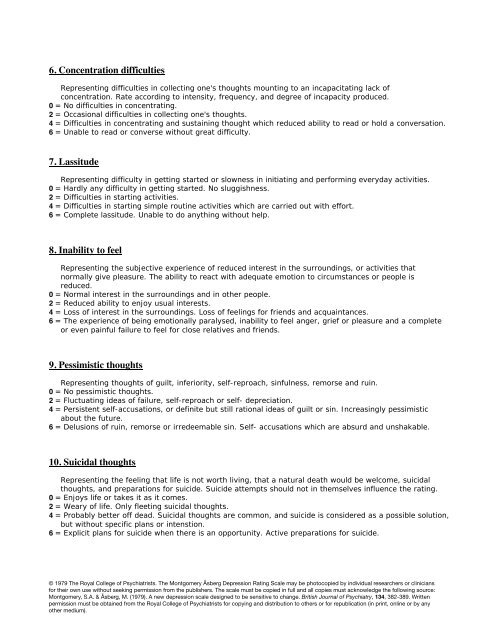Center for Epidemiologic Studies Depression Scale ... - myCME.com
Center for Epidemiologic Studies Depression Scale ... - myCME.com
Center for Epidemiologic Studies Depression Scale ... - myCME.com
You also want an ePaper? Increase the reach of your titles
YUMPU automatically turns print PDFs into web optimized ePapers that Google loves.
6. Concentration difficultiesRepresenting difficulties in collecting one's thoughts mounting to an incapacitating lack ofconcentration. Rate according to intensity, frequency, and degree of incapacity produced.0 = No difficulties in concentrating.2 = Occasional difficulties in collecting one's thoughts.4 = Difficulties in concentrating and sustaining thought which reduced ability to read or hold a conversation.6 = Unable to read or converse without great difficulty.7. LassitudeRepresenting difficulty in getting started or slowness in initiating and per<strong>for</strong>ming everyday activities.0 = Hardly any difficulty in getting started. No sluggishness.2 = Difficulties in starting activities.4 = Difficulties in starting simple routine activities which are carried out with ef<strong>for</strong>t.6 = Complete lassitude. Unable to do anything without help.8. Inability to feelRepresenting the subjective experience of reduced interest in the surroundings, or activities thatnormally give pleasure. The ability to react with adequate emotion to circumstances or people isreduced.0 = Normal interest in the surroundings and in other people.2 = Reduced ability to enjoy usual interests.4 = Loss of interest in the surroundings. Loss of feelings <strong>for</strong> friends and acquaintances.6 = The experience of being emotionally paralysed, inability to feel anger, grief or pleasure and a <strong>com</strong>pleteor even painful failure to feel <strong>for</strong> close relatives and friends.9. Pessimistic thoughtsRepresenting thoughts of guilt, inferiority, self-reproach, sinfulness, remorse and ruin.0 = No pessimistic thoughts.2 = Fluctuating ideas of failure, self-reproach or self- depreciation.4 = Persistent self-accusations, or definite but still rational ideas of guilt or sin. Increasingly pessimisticabout the future.6 = Delusions of ruin, remorse or irredeemable sin. Self- accusations which are absurd and unshakable.10. Suicidal thoughtsRepresenting the feeling that life is not worth living, that a natural death would be wel<strong>com</strong>e, suicidalthoughts, and preparations <strong>for</strong> suicide. Suicide attempts should not in themselves influence the rating.0 = Enjoys life or takes it as it <strong>com</strong>es.2 = Weary of life. Only fleeting suicidal thoughts.4 = Probably better off dead. Suicidal thoughts are <strong>com</strong>mon, and suicide is considered as a possible solution,but without specific plans or intenstion.6 = Explicit plans <strong>for</strong> suicide when there is an opportunity. Active preparations <strong>for</strong> suicide.© 1979 The Royal College of Psychiatrists. The Montgomery Åsberg <strong>Depression</strong> Rating <strong>Scale</strong> may be photocopied by individual researchers or clinicians<strong>for</strong> their own use without seeking permission from the publishers. The scale must be copied in full and all copies must acknowledge the following source:Montgomery, S.A. & Åsberg, M. (1979). A new depression scale designed to be sensitive to change. British Journal of Psychiatry, 134, 382-389. Writtenpermission must be obtained from the Royal College of Psychiatrists <strong>for</strong> copying and distribution to others or <strong>for</strong> republication (in print, online or by anyother medium).
















